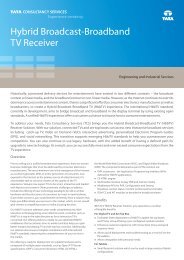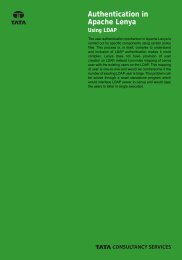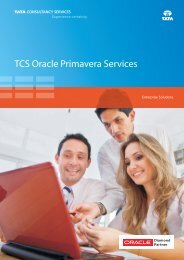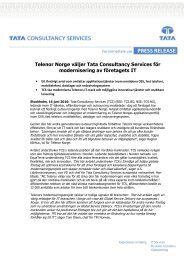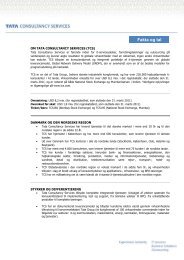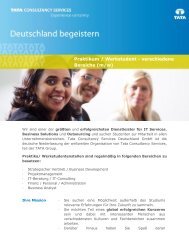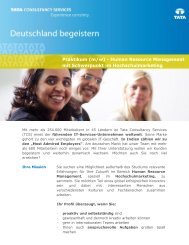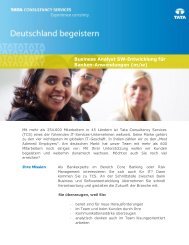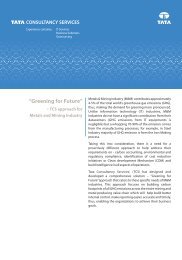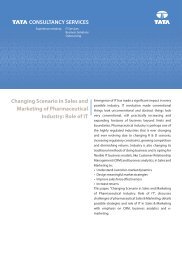Knowledge Management using Enterprise Content Management ...
Knowledge Management using Enterprise Content Management ...
Knowledge Management using Enterprise Content Management ...
You also want an ePaper? Increase the reach of your titles
YUMPU automatically turns print PDFs into web optimized ePapers that Google loves.
Web <strong>Content</strong> <strong>Management</strong><br />
An enterprise web site or portal is much more than a storefront or static digital brochure. It is a medium<br />
through which all known and unknown stakeholders namely customers, prospects, partners, suppliers, and<br />
employees interact with the enterprise. Through the web site partners, prospects and competitors learn<br />
about products and services of the enterprise. It enables your employees to be more effi cient and effective<br />
in their everyday work.<br />
A web site or portal that is powered by Web <strong>Content</strong> <strong>Management</strong> (WCM) system is capable of delivering<br />
dynamic, highly-personalized, multi-lingual content to individual customers, partners, and suppliers around<br />
the world. This will enable the knowledge of the enterprise to be effectively shared or used by all stakeholders.<br />
WCM solutions automate the complex process of creating, managing, and publishing content to web sites,<br />
portals and web applications in multiple languages and locales and for diverse audiences. WCM solution<br />
also empowers non-technical users to create, manage, and publish their own web content without the<br />
need to understand the complexities of technologies such as HTML or XML. An effective WCM solution<br />
eliminates the web team bottleneck and allows this group to streamline the entire web production process,<br />
thus enabling the enterprise to capture, manage and effectively use the knowledge of an enterprise.<br />
Digital Asset <strong>Management</strong><br />
Today, graphics fi les, photos, presentations, design layouts, streaming audio and video, and other richmedia<br />
assets alongside traditional documents are part of the content or knowledge that an enterprise<br />
generates or uses. To effi ciently manage this digital content, organizations look at software applications<br />
designed specifi cally to manage digital assets. Digital Asset <strong>Management</strong> (DAM) delivers business value<br />
and Return On Investment (ROI) through innovative and specialized methods of storing, organizing,<br />
distributing, and tracking digital media across multiple delivery channels. DAM provides businesses with the<br />
ability to leverage digital content effi ciently along the supply chain through production, postproduction, and<br />
distribution processes.<br />
DAM solutions provide enterprises in all industries with powerful capabilities for promoting products and<br />
services, educating employees, and establishing global brand recognition. This happens through the<br />
streamlining and unifi cation of the management of all multimedia and image-rich content.<br />
<strong>Enterprise</strong> Reports <strong>Management</strong><br />
Report management is the process of electronically capturing, indexing (adding intelligence), archiving and<br />
distributing reports to improve access to critical business information.<br />
As business operations expand across multiple locations and lines of business, enterprise reporting<br />
requirements grow in scope and complexity. The information that was once maintained in a single system<br />
and routed to a single destination, must now be captured from a variety of different sources, in an increasing<br />
number of fi le formats. In addition, different sections of reports need to be routed everywhere from user<br />
workstations to network printers, and from wireless devices to conventional retrieval processes.<br />
Traditionally, organizations have relied on paper-based processes to support these requirements. These<br />
processes were adequate when operations were nominal. But as enterprises reach a global scale, they<br />
impair the accessibility and usability of critical corporate information. To reduce operating costs and ensure<br />
that appropriate business users can extract the maximum value from report content, organizations need a<br />
designated output and report management solution.<br />
<strong>Enterprise</strong> Report <strong>Management</strong> system transform report content into meaningful business intelligence,<br />
empower business users with multi-channel distribution, reduce operating costs, eliminate wasted materials,<br />
enable resources to focus on the most valuable tasks, increase accuracy and effi ciency, and promote security<br />
and customer service.<br />
<strong>Enterprise</strong> <strong>Content</strong> <strong>Management</strong> System 6<br />
TATA CONSULTANCY SERVICES



